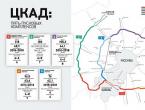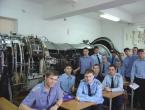Wastewater treatment plants for residential, commercial and industrial applications. Types of treatment facilities “Engineering equipment” - turnkey work of any complexity
"Engineering Equipment" offers equipment for the treatment and pumping of domestic, storm, and industrial wastewater. The scope of work includes the design, production, supply and installation of a wastewater treatment system. The main advantage of our company is comprehensive turnkey work on organizing wastewater treatment.
At Engineering Equipment you can not only buy wastewater treatment plants for your home or business. The price for underground or above-ground local installations depends on the complexity of the project. Detailed information can be obtained by calling 8-800-500-31-02.
The best domestic wastewater treatment plants!
"Tver". Highly efficient and reliable domestic wastewater treatment plant. The equipment is designed for deep mechanical and biological cleaning, a wide range of models is available, the system is selected according to customer requirements.
"Svir". Modern installation for treating melt and storm water wastewater. The scope of application of the equipment is the residential sector, gas stations, industrial facilities, etc. The system performs comprehensive filtration from various contaminants.
Grease traps. Elements of a wastewater treatment plant prevent oils and grease from entering the sewer system. The equipment is ideal for use in catering establishments and food industry facilities.
"Sviyaga". Provides recycling water supply. Effectively purify water from contaminants in car washes. The filtered liquid can be reused, which significantly reduces utility costs.
"Tver-S", "Svir-S". Sewage treatment stations at low temperatures. The units cope with high loads and operate smoothly, regardless of the climate.
High reliability of the system is achieved through the use of high-quality imported equipment.
"Desis". Reliable installation for disinfection of infected wastewater. Widely used in tuberculosis dispensaries and medical institutions where infectious diseases are treated. Suitable for other similar objects.
“Engineering equipment” - turnkey work of any complexity!
- Design - specialists from the technical department will design the facility in a short time.
- Production of installations - our company’s specialists will manufacture a treatment plant for a specific facility.
- Delivery to the customer - fast delivery of finished equipment to any point in Russia.
- Professional installation - the installation of wastewater treatment systems is carried out by experienced specialists. The masters have hundreds of successful projects under their belt!
- Start-up and commissioning - putting the system into operation and performing the necessary tests.
There are four complexes of treatment facilities on the territory of the enterprise. Treatment facilities No. 1 are designed to treat industrial wastewater from car washing and consist of seven settling tanks located in series. Washing is carried out with recycled water (water is pumped from the last settling tank to the sink).
Complexes of treatment facilities No. 2 and No. 3 are located on two branches of storm sewers parallel to the coastline of the river. Moscow.
Each complex of treatment facilities consists of a sedimentation tank, a syprone filter and an oil collector.
Pre-treated wastewater at treatment plants No. 2 and No. 3 is pumped to a post-treatment unit of the “Volna” type (treatment plant No. 4) and is then discharged into the river. Moscow. The design capacity of the Volna after-treatment unit is 72.0 m³/day. Treatment plants No. 2, No. 3 and No. 4 are located outside the territory of the enterprise, but within the water protection zone of the Moscow River.
The enterprise has designed, built and operates system No. 4 of stormwater and wastewater treatment facilities (Fig. 2) consisting of:
cleaning unit “Volna” - 1 pc.;
receiving tanks - 2 pcs.;
intrasite networks;
submersible pump “Gnome-10” - 2 pcs.;
instrumentation system and A.
Cleaning method: mechanical, with elements: pressure filtration and sorption. Productivity up to 3 m3 per hour.
Concentration of pollutants in the incoming effluent:
- - suspended substances (S.S.) - up to 100 mg/l;
- - petroleum products (NP) - up to 20 mg/l.
Effluent concentration after treatment facilities:
V.V. - no more than 10 mg/l;
N.P. - no more than 0.05 mg/l.
Figure 2 - Technological diagram of the “Volna” storm drainage treatment plant
The Volna treatment plant operates as follows. Stormwater contaminated with suspended substances and petroleum products flows along the natural slope of the territory or storm drain (collector) into receiving tank 1. Here the flow rate drops sharply, sedimentation and accumulation of large suspended particles and separation of undissolved petroleum products in water occurs. A coarse filter installed in the receiving tank 1 prevents the removal of pollutants into the water intake area of the “dirty water” pump 2. Next, the clarified water is pumped into the “Volna” cleaning unit 3 for cleaning by the “dirty water” submersible pump 2. The pump is switched on automatically as it rises the water level in the receiving tank 1 to a certain level; The pump also switches off automatically when the level drops. The pressure line is equipped with a valve to regulate the optimal performance of the cleaning unit and can be equipped with a check valve.
The Volna 3 purification unit is equipped with four successive stages of reference filtration, made in the form of removable cassettes. After the last stage, purified water can be reused or discharged into a storm sewer.
The filter materials used at each stage of cleaning of the Volna block differ from each other and are non-woven compositions made of textile fibers of various compositions:
- - Lavsanite
- - KM-1/400
- - KM-2
- - KM - 1/170
- - Sintenit-P
- - Carbon felt
- - Foam rubber.
The selection of filter materials, their volume and combination is carried out depending on the composition of the wastewater in each specific case during commissioning and is specified during the warranty period of operation.
Over time, filtered sludge of fine suspended matter accumulates at the bottom of the cleaning unit. To remove it and regenerate the filters, there are four valves located in the lower part of block 3. When they are periodically opened, the sludge flows through the pipeline to the sand area 4, where it is dewatered and accumulated for disposal. The filtrate from the sludge, having passed through the coarse filter with which the sand site is equipped, again enters the receiving tank 1 and is sent for cleaning.
The city sewerage system is laid further than 500 m from the territory of the Mechanization Department base. Therefore, laying a domestic sewerage network from the base to the city network is impractical and expensive construction. In this regard, the discharge of domestic water on the basis of the Mechanization Department is carried out into concrete storage tanks for storm water.
On the territory of the base there are two concrete tanks - storage tanks with a volume of 12 m3 (Fig. 3) and 8 m3, with metal caissons inserted inside with very reinforced insulation.
Storm water treatment plants are cleaned as suspended solids and petroleum products accumulate in them. Suspended substances are extracted and transported by pneumatic tanker from the territory of the base in accordance with an agreement with JSC Khoroshevskoye Road Administration.
Currently, the wells are in satisfactory condition. There are no complaints against the company for untimely removal of fecal water.
To treat surface runoff coming from areas from 0.1 Hectares to 10 Hectares, we have developed treatment plants of the Volna-1 series TU 4859-003-68995916-2010 of ten standard sizes with a capacity of 1.0 m 3 /hour; 1.8m 3 /hour; 3.6m 3 /hour; 5m 3 /hour; 10m 3 /hour and 18m 3 /hour.
Technical characteristics of storm drain treatment plants of the Volna-1 series.
Treatment plants "Volna" manufactured by LLC "Stroyspetsmontazh+21" TU 4859-003-68995916-2010 (TU 5265-002-18274347-2006), registered by GOSSTANDART of Russia under No. 200/056578, have a valid Certificate of Conformity No. ROSS RU.AB75. N02587 (ROSS RU.AG40.N01182); Sanitary and epidemiological expert conclusion No. 468-02-EZ (77.01.03.526.T.066192.10.06) and a positive conclusion of the State Environmental Expertise of the Federal Service for Environmental, Technological and Nuclear Supervision in the Central Federal District (ROSTEKHNADZOR) No. 02-EE- 93237-06 dated 09/08/06, which recognized them as standard.
The operating principle of the treatment plant is based on mechanical methods of wastewater treatment (14 technological transitions) without the use of chemicals. This is thin-layer sedimentation, forced and pressure-free filtration on needle-punched bag filters with preliminary clarification of water in a hydrocyclone and an oil trap; sequential filtration on packed fine-fiber filters of three stages of purification; flotation using a vortex water-air ejector and subsequent gravity filtration using synthetic nonwoven materials, as well as post-purification using carbon fiber sorbents.
The design of the treatment plant provides for the possibility of adjusting the loading of filter elements in terms of composition and volume at different stages of purification, which, without unnecessary costs, allows, based on water analyzes made during commissioning work, to bring the degree of purification to the required standards, depending on the concentration of contaminants in the incoming wastewater.
The treatment plant is factory-manufactured (fully complete) from steel 4-6 mm thick with internal partitions and filter frames, and covered with a two-layer polymer anti-corrosion composition. All filter elements are domestically produced, made on the basis of modern synthetic textile materials and activated carbon fibers.
Treatment plants operate in automatic water circulation mode and require only periodic monitoring. For this purpose, the external panel of the control unit is equipped with a light alarm for turning on and off the pumps, as well as the degree of contamination of the filter elements. The system is provided for switching to “manual” control of pump operation in the event of a sudden occurrence of excess precipitation.
To ensure year-round operation (including during thaws), technological modules are mounted buried in the ground to the level of the design mark and closed with additional internal insulated covers; their side walls are insulated from the outside along the perimeter with extruded polystyrene foam 100 mm thick to the depth of soil freezing. In this regard, there is no need for additional heating of the treatment plant and the construction of a warm building or pavilion above it. All covers of the treatment plant are removable, which provides free access to any technological compartment and convenience when carrying out routine maintenance and removal of filtration products.
Installation of the treatment plant can be carried out by the Customer on his own according to the attached instructions.
When installed, treatment plants "Volna-1" can be grouped into several units with parallel connections to achieve a given total productivity (for example, "Volna-1-18" + "Volna-1-18" = "Volna-1-36").
Technological diagram of the Volna-1 treatment plant

|
1. Distribution well |
14.Pressure bag filters. |
27. Packed filter No. 1. |




